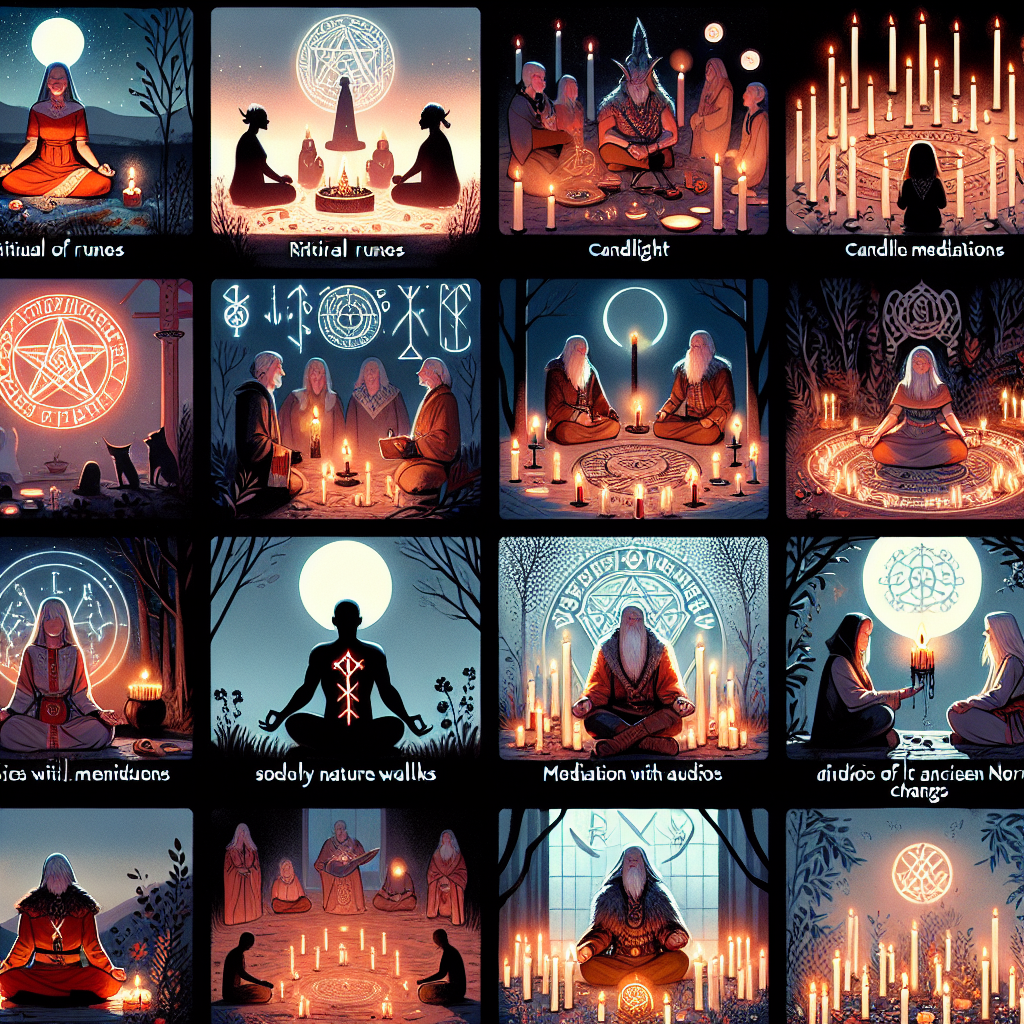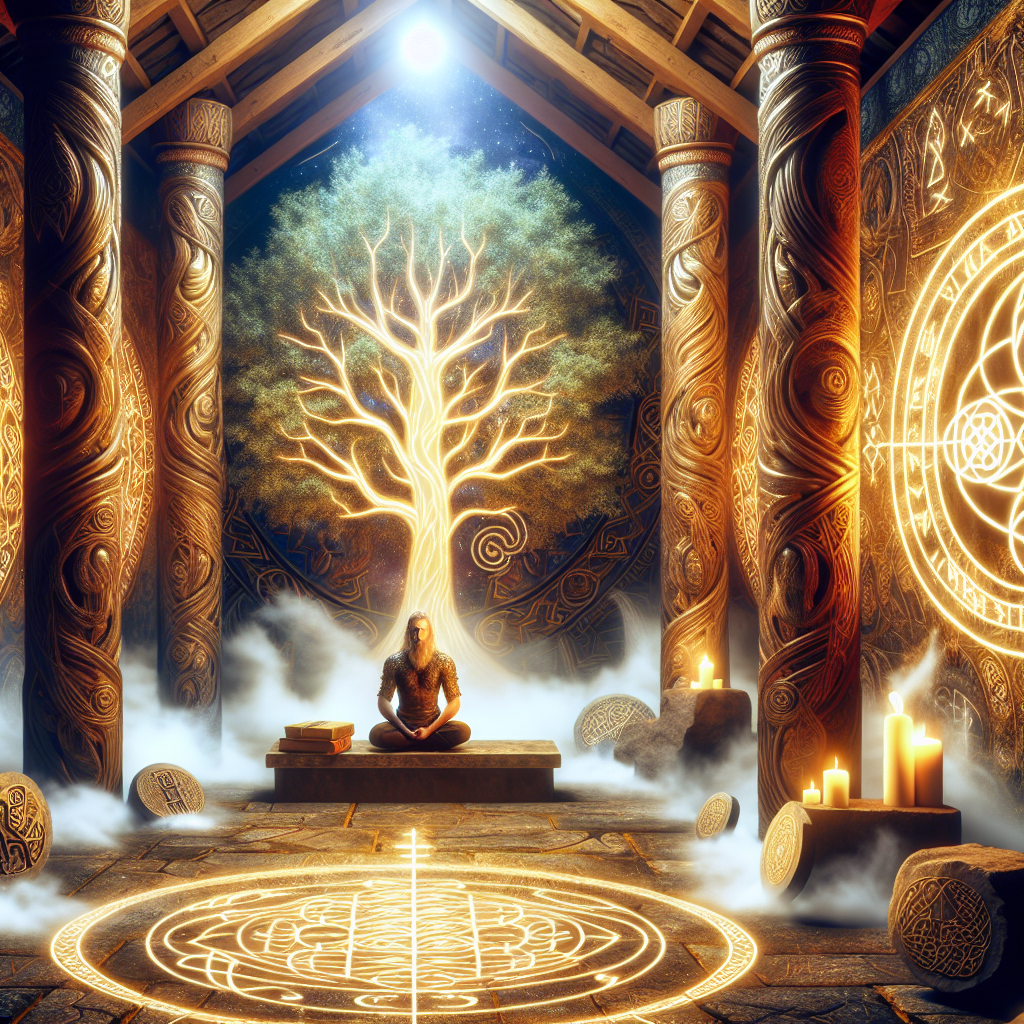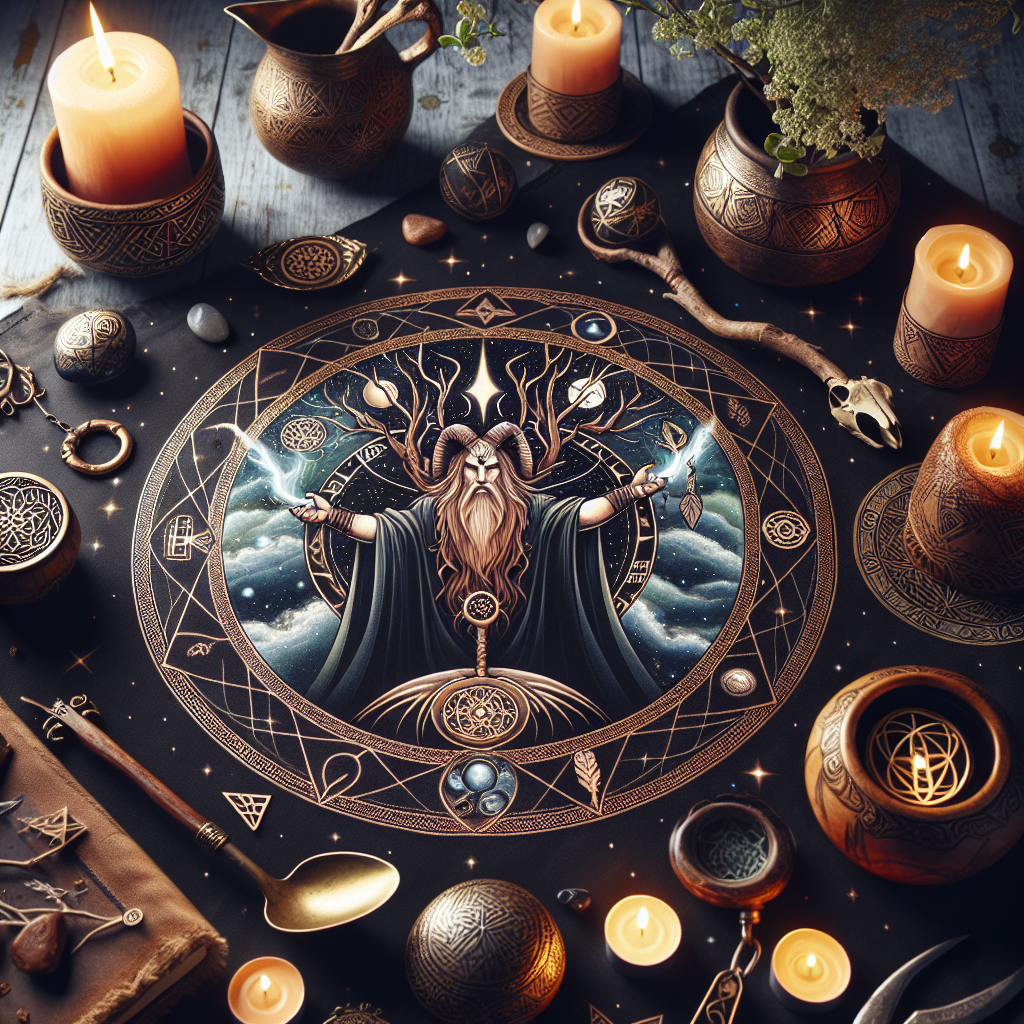As an Amazon Associate I earn from qualifying purchases.

03ch203eIntroduction to Norse Pagan Practices03/h203e
03ch303eBackground and Current Significance03/h303e
Norse Pagan practices have been rooted in ancient Scandinavian traditions, thriving long before the spread of Christianity. Modern-day practitioners, known as Heathens or Ásatrúar, continue these traditions as a means to achieve spiritual growth and a deeper connection with nature and their ancestors. According to a survey by the Pew Research Center, the number of people identifying with Norse Paganism has seen a steady increase, highlighting a resurgence in these ancient practices.
03ch203e20 Norse Pagan Practices for Spiritual Growth03/h203e
03ch303e1. Blót03/h303e
Blót, or sacrificial offerings, are central to Norse Pagan rituals. These sacrifices can be of food, drink, or other valuables, given to the gods, goddesses, and spirits as a way to garner favor and show respect.
03ch303e2. Sumbel03/h303e
Sumbel is a significant communal drinking ritual where participants toast to gods, ancestors, and heroes. This act of camaraderie and shared spiritual experience strengthens communal bonds and personal devotion.
03ch303e3. Seidr03/h303e
Seidr is a form of Norse magic and shamanism that involves trance work, divination, and interaction with the spirit realm. Practitioners use it to gain wisdom, solve problems, and facilitate healing.
03ch303e4. Galdr03/h303e
Galdr is the practice of using magical songs or chants to bring about desired outcomes. These incantations are believed to harness the power of the spoken word to influence reality.
03ch303e5. Runes03/h303e
Runes serve as both an ancient alphabet and a divinatory tool. Each rune holds specific meanings and is used in casting rituals to gain insight into various life questions and decisions.
03ch303e6. Fylgia03/h303e
Fylgia are guardian spirits that accompany individuals through life. Identifying and communicating with one's Fylgia can provide guidance, protection, and personal growth.
03ch303e7. Ancestor Worship03/h303e
Honoring ancestors is a profound aspect of Norse Paganism. Rituals often involve offerings and prayers to deceased relatives to gain their favor and wisdom.
03ch303e8. Yggdrasil Meditation03/h303e
Yggdrasil, the World Tree, holds a special place in Norse cosmology. Meditating on Yggdrasil can help practitioners connect with the different realms and beings of existence, fostering spiritual insights.
03ch303e9. Hallowing03/h303e
Hallowing is the practice of sanctifying spaces or objects through rituals and blessings. This creates a sacred environment conducive to spiritual growth and protection.
03ch303e10. Veizla03/h303e
Veizla refers to a feast held in honor of gods or significant events. These communal gatherings strengthen bonds and allow participants to celebrate shared beliefs and spirituality.
03ch303e11. The Nine Noble Virtues03/h303e
Practitioners strive to embody the Nine Noble Virtues: courage, truth, honor, fidelity, discipline, hospitality, self-reliance, industriousness, and perseverance. Living by these principles supports personal and spiritual development.
03ch303e12. Þing03/h303e
Þing, or assemblies, are gatherings to discuss and resolve community issues, perform rituals, and share knowledge. Participation in Þing fosters a sense of community and collective spiritual growth.
03ch303e13. Sacred Sites03/h303e
Visiting and honoring sacred sites, such as burial mounds, ancient forests, and natural landmarks, strengthens a practitioner's connection with the land and its spirits.
03ch303e14. Crafting03/h303e
Creating objects such as pendants, talismans, and rune sets imbued with personal and spiritual significance is a form of devotion and a means to channel divine energies.
03ch303e15. Spirit Journeys03/h303e
Spirit journeys are undertaken to explore the other realms, meet guiding spirits, and seek insights into one's life. These journeys are facilitated through drumming, chanting, or meditation.
03ch303e16. Ritual Drama03/h303e
Enacting mythological stories through ritual drama allows practitioners to experience the divine narratives in a personal and transformative way, reinforcing their spiritual beliefs and practices.
03ch303e17. Symbel03/h303e
Much like Sumbel, Symbel is a ritualistic toasting ceremony, but with a greater focus on making solemn boasts, oaths, and vows, thereby reinforcing one's personal honor and commitment.
03ch303e18. Divination03/h303e
Besides runes, Norse Pagans may use other forms of divination like tarot or omens to gain insights from the divine, guiding them through life's challenges and decisions.
03ch303e19. Seasonal Celebrations03/h303e
Celebrating the changing seasons and significant points in the agricultural calendar, such as Yule and Midsummer, aligns practitioners with the natural rhythms of the earth.
03ch303e20. Personalized Altars03/h303e
Creating altars personalized with idols, candles, and offerings provides a focal point for daily worship and spiritual activities, helping practitioners to maintain a consistent spiritual practice.
1. **Blót (Sacrificial Rituals)**
Blót is integral to Norse Paganism, a sacrificial ritual where offerings such as mead, food, or animal sacrifices are made to the gods, spirits, and ancestors. It fosters spiritual growth by connecting practitioners with the divine and honoring sacred traditions dating back to antiquity.
2. **Symbel (Sacred Feast)**
The Symbel is a communal feast where toasts and oaths are made, often in honor of gods and ancestors. It encourages personal development by promoting virtues such as bravery, loyalty, and community bonding, essential values in Heathen rituals.
3. **Runic Divination**
Utilizing runes for divination, known as ‘casting the runes,' offers guidance and insights into personal and spiritual questions. This ancient practice fosters spiritual growth through enhanced self-awareness and mystical connection to the divine energies embodied in the runes.
4. **Seiðr (Shamanic Practices)**
Seiðr encompasses Norse shamanic traditions, including trance work, prophecy, and magical workings. Engaging in Seiðr aids in cultivating deep spiritual experiences and personal development, by expanding one's consciousness and abilities to interact with other realms.
5. **Vé (Sacred Spaces)**
The creation and maintenance of sacred spaces or ‘Vé' in one's home or outdoor environment is a fundamental Norse practice. These spaces act as a focal point for meditation, prayer, and holy rites, promoting a serene and spiritually focused atmosphere.
6. **Hof (Temple Worship)**
Regular attendance and participation in rituals at a Hof, a dedicated temple space, strengthens communal ties and personal spirituality. Involvement in these rituals enhances collective and individual spiritual growth through shared divine practices.
7. **Ancestor Worship**
Honoring ancestors through altars, offerings, and remembrance rituals is a cornerstone of Norse Pagan practice. This cultivates a continuous link between the living and the dead, fostering personal development through appreciation of heritage and familial bonds.
8. **Althing (Gathering)**
The Althing, a traditional assembly, facilitates communal decision-making and legal matters. Participating in such gatherings builds community solidarity and allows individuals to grow through collective action and governance.
9. **Namings and Rites of Passage**
Ceremonies marking significant life events—such as birth, puberty, marriage, and death—serve as key Norse practices. These rituals, steeped in tradition, provide structure and sacred acknowledgment of personal milestones, enhancing spiritual and communal connection.
10. **Seasonal Festivals**
Celebrating seasonal changes through festivals like Yule, Ostara, and Midsummer ties practitioners to the cycles of nature. These festivals, full of specific Heathen rituals, enrich spiritual growth by harmonizing individual experiences with natural rhythms.
11. **Meditative Practices**
Incorporating meditation into daily life helps individuals achieve mental clarity and spiritual serenity. Norse-focused meditation often involves revered symbols like the World Tree, Yggdrasil, fostering spiritual enlightenment and connection to the cosmos.
12. **Gandr (Wand Magic)**
The use of Gandr, or magical wands, in Norse spells and rituals highlights the importance of tools in divine practices. These objects aid personal development by focusing intent and channeling energy, pivotal for effective magical workings.
13. **Eddas and Sagas Study**
Immersing in the study of Eddas and Sagas, the primary sources of Norse mythology, enriches spiritual growth. Understanding these texts deepens knowledge of mythic archetypes and ancient wisdom, integral to Heathen religious practice.
14. **Saga Telling and Poetic Edda Recitations**
Practicing oral traditions, such as saga telling and reciting the Poetic Edda, preserves cultural heritage and promotes memory and eloquence. This practice links spiritual and intellectual development, reinforcing community culture.
15. **Nature Walks and Foraging**
Engaging actively with nature through mindful walks and foraging connects practitioners with the land spirits. This physical interaction with the environment is a powerful way to foster spiritual growth and a deep sense of belonging.
16. **Crafting Sacred Items**
Creating personal ritual tools or sacred objects, like amulets or statues of gods, involves a creative connection with the divine. Crafting these items is a spiritual practice of devotion and personal expression in Norse tradition.
17. **Story and Myth Re-enactments**
Re-enacting myths and legendary tales from Norse lore brings stories to life and serves as a dynamic form of worship. This interactive practice cultivates a deeper understanding of divine archetypes and personal growth.
18. **Pilgrimage to Sacred Sites**
Visiting sites of historical and spiritual significance, such as ancient temples or natural landmarks linked to Norse mythology, enhances spiritual awareness. Pilgrimage functions as an act of devotion and a journey toward greater spiritual insight.
19. **Libations**
Pouring out libations of mead or other sacred liquids as offerings to the gods or land spirits is a common ritual. This act of giving fosters humility and respect, integral to spiritual growth and divine practice within Norse traditions.
20. **Spiritual Journaling**
Keeping a journal dedicated to spiritual reflections, runic interpretations, and ritual experiences aids personal development. Documenting these insights allows practitioners to track their spiritual growth and deepen their relationship with the sacred.
According to recent studies, about 300,000 individuals in the United States alone actively participate in various forms of modern Paganism, highlighting the growing interest in these spiritual practices.
Engaging with the Runes
One of the core Norse pagan practices I adopted for spiritual growth is engaging with the runes. I started with basic rune casting and gradually moved to more intricate methods such as the three-rune spread for daily guidance. The runes serve as an insightful tool for reflection and forecasting, which has significantly enhanced my intuitive abilities.
I also incorporated rune meditation into my routine. Spending time contemplating each rune's meaning and energy helped me to deeply internalize their significance. This practice not only provided clarity during challenging times but fostered a more profound connection with the mysteries of the universe.
Making my own set of runes was another enriching experience. I spent time selecting the right wood, carving each rune, and anointing them with oils. This personalization process imbued the runes with my own energy, further strengthening my spiritual toolset and allowing for more accurate readings and meditations.
Observing the Seasonal Blóts
Celebrating the seasonal blóts has been a transformative experience. These are significant Norse rituals that mark the changing of the seasons and honor various deities. Since adopting these practices, I feel a deeper alignment with the natural cycles of the Earth. Participating in Yule, Ostara, and other key blóts has created a rhythmic structure to my spiritual life, fostering a sense of grounding and continuity.
During these celebrations, I make offerings to the gods and goddesses associated with the season. These offerings can range from food and mead to handmade items. Preparing these offerings allows for a period of reflection, enhancing the sacredness of the ritual and deepening my connection with the divine.
Additionally, I often hold communal blóts with other practitioners. These gatherings provide a sense of community and shared purpose, reinforcing the communal aspect of spirituality that is central to Norse paganism. The exchange of stories, experiences, and spiritual energy during these ceremonies has been incredibly enriching.
Building an Altar
Building and maintaining an altar dedicated to the Norse deities has been a profound part of my spiritual journey. My altar is a sacred space where I place representations of the gods, family heirlooms, and items from nature. This practice has become a daily reminder of the divine presence in my life.
Regularly updating and tending to the altar keeps the spiritual energy vibrant. I clean it often, adjust the arrangement of items based on intuitive guidance, and leave offerings. This constant interaction with my altar has cultivated a sense of consistency and devotion, reinforcing my spiritual practices.
Celebrating milestones and life events at my altar has also been meaningful. Whether it's a personal achievement or a significant life change, marking these moments with a brief ritual at the altar has been grounding and affirming. It serves as a physical representation of my spiritual path and growth.
Connecting with Ancestors
Honoring and connecting with my ancestors is another important Norse practice I’ve embraced for spiritual growth. This began with researching my family lineage, which brought a new dimension to my understanding of self and heritage. By learning about my forebears, I feel a sense of belonging and continuity.
I established an ancestral altar where I place photographs, mementos, and symbolic items related to my ancestors. This space offers a way to communicate with them through offerings, prayers, and meditation. Paying respects in this manner has provided comfort and guidance, bridging the gap between past and present.
To deepen this connection, I’ve participated in ceremonies such as the Dísablót, dedicated to female ancestors. These rituals provide an opportunity to honor their wisdom and seek their insights. Engaging in ancestral veneration has brought a deeper level of spiritual fulfillment, fostering a legacy of resilience and strength.
u003ch2u003eFAQ 1: What are some recommended Norse Pagan Practices for spiritual growth?u003c/h2u003e
u003cpu003eNorse Pagan practices for spiritual growth often involve connecting with nature, honoring deities, performing rituals, and studying the Eddas and Sagas. Meditative walks, offering blóts, and engaging in rune work can also enhance spiritual development.u003c/pu003e
u003ch2u003eFAQ 2: How can modern practitioners begin incorporating Heathen rituals into their daily lives?u003c/h2u003e
u003cpu003ePractitioners can start by setting up a simple altar with symbols of Norse deities, performing daily invocations or blóts, and celebrating key Norse festivals such as Yule and Midsummer. Regularly reading Norse texts and learning about the gods' stories can also deepen their practice.u003c/pu003e
u003ch2u003eFAQ 3: What are blóts and how are they performed?u003c/h2u003e
u003cpu003eBlóts are sacrificial rituals to honor the gods, ancestors, or spirits. They typically involve offering food, drink, or items of value. The ritual often includes a form of invocation, speaking words of thanks, and communal sharing of the offering.u003c/pu003e
u003ch2u003eFAQ 4: Can Norse Pagan practices be adapted for solitary practitioners?u003c/h2u003e
u003cpu003eAbsolutely. Many Norse Pagan practices, including rune magic, meditation, and personal blóts, can be performed alone. It's important to create a personal routine that feels meaningful and intimate.u003c/pu003e
u003ch2u003eFAQ 5: How important is nature in Norse Paganism?u003c/h2u003e
u003cpu003eNature plays a critical role in Norse Paganism. Many rituals and spiritual practices involve a deep connection to nature, and the gods themselves are often associated with natural elements. Engaging with nature through activities like planting, hiking, or observing seasonal changes can enhance spiritual experiences.u003c/pu003e
u003ch2u003eFAQ 6: What are runes, and how can they be used for personal development?u003c/h2u003e
u003cpu003eRunes are ancient symbols that the Norse used for writing, divination, and magical purposes. They can be used for spiritual insight and guidance. Practitioners can draw runes for daily inspiration, meditation, or to support spellwork and rituals.u003c/pu003e
u003ch2u003eFAQ 7: How do Norse Pagan practices promote personal growth?u003c/h2u003e
u003cpu003eNorse Pagan practices encourage introspection, discipline, and a connection to larger cosmic cycles. They often require practitioners to cultivate skills like meditation, ritual crafting, and ethical behavior, all of which can lead to significant personal growth.u003c/pu003e
u003ch2u003eFAQ 8: What role do the Norse gods play in personal spiritual practices?u003c/h2u003e
u003cpu003eThe Norse gods serve as guides, protectors, and sources of inspiration. Involving them in your spiritual practice can enhance your personal connection to the divine and provide a framework for moral and ethical guidance.u003c/pu003e
u003ch2u003eFAQ 9: Are there any key texts that are essential for understanding Norse Paganism?u003c/h2u003e
u003cpu003eImportant texts include the Poetic Edda, the Prose Edda, and the Sagas of Icelanders. These works provide foundational myths, legends, and poetry that form the backbone of Norse Pagan understanding and practice.u003c/pu003e
u003ch2u003eFAQ 10: How can someone respectfully incorporate Norse Pagan practices into their spiritual life?u003c/h2u003e
u003cpu003eRespectful incorporation can be achieved through diligent study, genuine intent, and ethical practice. Avoid cultural appropriation by learning from reliable sources, engaging with practitioners, and maintaining a sincere and respectful approach to the traditions.u003c/pu003e

Conclusion
Norse Pagan practices offer a rich tapestry of rituals and traditions that can significantly facilitate spiritual growth. Embracing these practices allows individuals to deepen their connection with the divine, nature, and their inner selves. The varied customs, from rune casting and honoring the ancestors to the mindful celebration of seasonal festivals like Yule and Ostara, serve as conduits for introspection and heightened spiritual awareness. Meditation with Norse deities like Odin and Freyja, coupled with the disciplined practice of Seidr, nurtures a profound spiritual connection and paves the way for personal development. Regular blóts and symbels, wherein offerings are made to the gods and sacred oaths are taken, help cultivate a sense of reverence and accountability.
Engaging with Heathen rituals, such as the creation and use of personal altars and the veneration of land wights, anchors one’s practice in the physical world while remaining attuned to the spiritual realm. These rituals extend to daily life through simple, yet profound, activities like reading the Eddas and Sagas to draw wisdom from ancient texts. Acts of service, protection magic, and even the crafting of magical tools all form integral parts of a holistic approach to spiritual growth. Each practice, whether solitary or communal, offers pathways to build resilience, find balance, and lead a purposeful life aligned with the principles of Norse Paganism. Thus, the convergence of these diverse practices enriches not just the individual’s spirit, but also strengthens their ties to the broader Heathen community.
Amazon and the Amazon logo are trademarks of Amazon.com, Inc, or its affiliates.


